Student rangers’ stories from the field, 2022 edition
Categories:
We had another incredible season with our 52 student rangers. We had a chance to catch up with a few of them at the end of their terms to learn about a few of the projects they accomplished.
The Student Ranger Program, now in its fifth year, is made possible through funding from the BC Parks Licence Plate Program and the federal government. Crews of two or four work on projects throughout the province in the areas of recreation, public outreach, conservation, and Indigenous reconciliation.
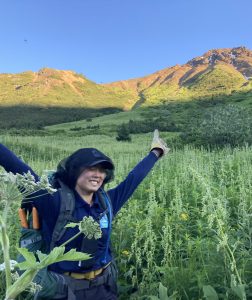
Sienna and Danielle in Dease Lake
Sienna and Danielle were a crew of two based in Dease Lake. On one of their work trips, they flew onto the top of Chakima Pass in Mount Edziza Provincial Park. Over five days, they did maintenance on a 16-kilometre section of a 70 km trail, where limited maintenance resources have been allocated for many years.
In the first section of the trail, there’s a long creek crossing. They cut a new section of the trail next to the creek to reduce how far people are crossing in the water. Trail maintenance involved cutting back branches and trail marking for future maintenance.
“It’s a very difficult trail to go through with lots of bushwhacking and stream crossings. I carried about 55 pounds of gear into the park, including fuel for the chainsaws, which the rangers carried and used later,” said Sienna. “We also took iNaturalist photos and loaded them up later.”
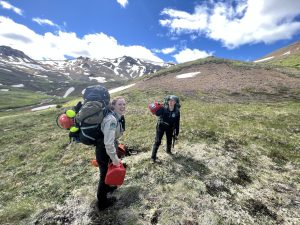
Over the summer they also added gravel to a portage trail, built a shed in the Dease Lake compound for winter storage; and dug one to two pit toilets every day for six days in Atlin/Áa Tlein Téix’i Provincial Park.
Sienna is going into her second year at BCIT in Fish, Wildlife and Recreation. When she graduates, she said “I would like to go into a BC Parks ranger auxiliary position. I would love to be a full time BC Parks ranger someday.”
“I hope the next people have a really great experience here. I’m going to miss the Dease Lake team. It’s not an experience that you can describe very well, it’s a feeling you have when you connect with people.”
Danielle LaBreche has just graduated from Simon Fraser University with a major in physical geography and a minor in biological science. She grew up in Burnaby, so moving to Dease Lake was a big change: “It’s definitely different. Everyone was saying how rural and far away it was, but it wasn’t as hard as I was expecting.”

Danielle and Sienna also spent a week in Tatshenshini-Alsek Provincial Park. Here, they worked on well water monitoring, brush cutting around signs, and checked the condition of an old cabin, bridge and old highway route. They also biked and hiked nine kilometres on the Chuck Creek Trail to help build a new section of the trail by digging out the top layer of organics and soil, and then laying down gravel.
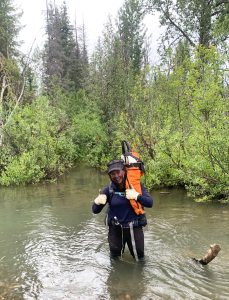
Another trip brought them to Cold Fish in Spatsizi Plateau Wilderness Provincial Park, one of Danielle’s high points of the summer: “We got to fly in on a float plane. A definite highlight to see the park by flying.”
One of the tasks Danielle described was to install wire fencing along the bottom of the cabins to prevent porcupines and packrats from living underneath and getting into the cabins. They dug six-inch-deep trenches to bury the wire so that animals can’t go underneath in the rain, “right under the drip line”, she laughs.
In the future, Danielle is looking for an auxiliary ranger position with BC Parks and is going to see what happens after that. Her advice for future student rangers is “to have a good attitude and be open to whatever you are asked to do – [there are] lots of new things to learn. I think part of being a ranger is there is so many different aspects you can end up doing.”
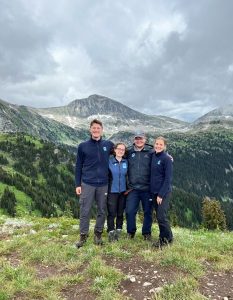
Karl in Kamloops
Karl Hare is another student ranger crew member and is based in Kamloops. Karl is going into his fifth year as a Bachelor of Science student in geography at the University of Victoria. Many of Karl’s workdays this summer involved going into the Trophy Mountain area in Wells Gray Provincial Park. A main project the crew worked on was updating the Asset Management System (AMS) that involved inventorying all park assets assessing their condition, noting anything that needed fixing.

Karl also thrived in the wild and appreciated its beauty, while working hard to clear trails. He enthusiastically recalled wandering down “a trail that goes through wildflowers – it’s all so pretty! We did lots of clearing of fallen trees that had come down in the winter and we did it all by handsaw.”
The crew also went down the Canyon Lands (Clearwater River Trail) in Wells Gray for three days of brush cutting, where there were “pretty hardcore bugs”. Other days weren’t as buggy, and he reminisced about a day spent near Moul Falls where he saw “the prettiest waterfall I’ve ever seen. It was one of the best days that we had, and so many people on the trail were thanking us for helping out on the trails.”
Karl enjoyed his time in Kamloops, noting that “it was really interesting to see and experience a different terrain around Kamloops. I grew up in Calgary and am going to school in Victoria, so I’d never experienced this kind of geography.”
New surroundings, beautiful waterfalls, gorgeous scenery… but what was it that really made his summer? “Mostly it came down to the crew, the friends that I made – that made it a really good summer.”

Jonathan in Terrace
Jonathan Diamantstein is a student ranger crew lead based in Terrace, B.C. He is studying environmental sciences at Concordia University in Montreal and grew up in Ottawa.
Jonathan enthusiastically reflects on his summer as a student ranger: “It was an incredible way to meet a lot of people who have gone multiple ways in their professional career and opened my eyes to the possibilities for myself. I’m constantly learning. It’s been incredible.”
One of Jonathan’s favourite photos of the last two summers was from last year, when he was a crew member. In the photo, he is wearing brush clearing gear, and he mentions that “it encompasses everything I love about the job. I have everything I need, all the safety gear, all the equipment, to protect myself and do the best job possible.”
Jonathan has really appreciated the opportunity to see the north, having been brought up and going to school in Ontario. He plans to move to BC permanently, specifically the Skeena West area, reflecting “I love how lush and green everything is in this area. It’s so diverse and beautiful. You can go from being in the rainforest to inland coastal forest, to the alpine – an amazing place.”
Prior to the July Nisga’a Memorial Lava Bed Provincial Park anniversary and naming ceremony, Jonathan and his crew were honoured to work on an important trail: “It was an amazing day. The trail has restricted access. You need a member of the Nisga’a Nation to give you a tour. We were given permission to work in the area and prepare the trail for the event.”
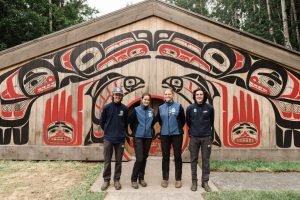
“The community here, the staff members (of BC Parks) at the office, it’s been so welcoming, it’s been so easy to work and thrive and grow.”
The Student Ranger Program is made possible by funding from the BC Parks Licence Plate Program and the federal government, in partnership with Project Learning Tree Canada. If you are interested in becoming a Student Ranger or Auxiliary Ranger, job postings go up as early as December and we will post here with details.





